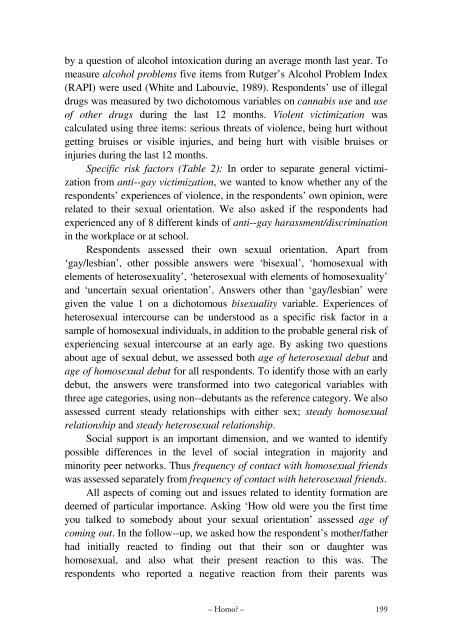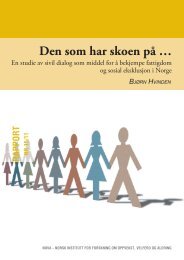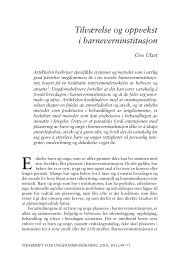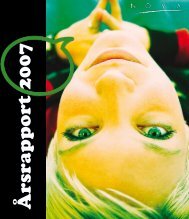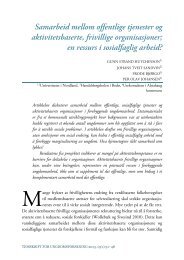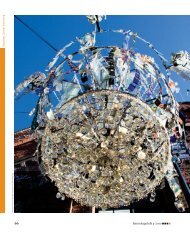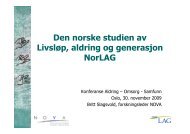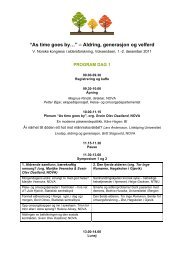Betydningen av seksuell erfaring, tiltrekning og identitet for ...
Betydningen av seksuell erfaring, tiltrekning og identitet for ...
Betydningen av seksuell erfaring, tiltrekning og identitet for ...
Create successful ePaper yourself
Turn your PDF publications into a flip-book with our unique Google optimized e-Paper software.
y a question of alcohol intoxication during an <strong>av</strong>erage month last year. To<br />
measure alcohol problems five items from Rutger’s Alcohol Problem Index<br />
(RAPI) were used (White and Labouvie, 1989). Respondents’ use of illegal<br />
drugs was measured by two dichotomous variables on cannabis use and use<br />
of other drugs during the last 12 months. Violent victimization was<br />
calculated using three items: serious threats of violence, being hurt without<br />
getting bruises or visible injuries, and being hurt with visible bruises or<br />
injuries during the last 12 months.<br />
Specific risk factors (Table 2): In order to separate general victimization<br />
from anti--gay victimization, we wanted to know whether any of the<br />
respondents’ experiences of violence, in the respondents’ own opinion, were<br />
related to their sexual orientation. We also asked if the respondents had<br />
experienced any of 8 different kinds of anti--gay harassment/discrimination<br />
in the workplace or at school.<br />
Respondents assessed their own sexual orientation. Apart from<br />
‘gay/lesbian’, other possible answers were ‘bisexual’, ‘homosexual with<br />
elements of heterosexuality’, ‘heterosexual with elements of homosexuality’<br />
and ‘uncertain sexual orientation’. Answers other than ‘gay/lesbian’ were<br />
given the value 1 on a dichotomous bisexuality variable. Experiences of<br />
heterosexual intercourse can be understood as a specific risk factor in a<br />
sample of homosexual individuals, in addition to the probable general risk of<br />
experiencing sexual intercourse at an early age. By asking two questions<br />
about age of sexual debut, we assessed both age of heterosexual debut and<br />
age of homosexual debut <strong>for</strong> all respondents. To identify those with an early<br />
debut, the answers were trans<strong>for</strong>med into two categorical variables with<br />
three age categories, using non--debutants as the reference category. We also<br />
assessed current steady relationships with either sex; steady homosexual<br />
relationship and steady heterosexual relationship.<br />
Social support is an important dimension, and we wanted to identify<br />
possible differences in the level of social integration in majority and<br />
minority peer networks. Thus frequency of contact with homosexual friends<br />
was assessed separately from frequency of contact with heterosexual friends.<br />
All aspects of coming out and issues related to identity <strong>for</strong>mation are<br />
deemed of particular importance. Asking ‘How old were you the first time<br />
you talked to somebody about your sexual orientation’ assessed age of<br />
coming out. In the follow--up, we asked how the respondent’s mother/father<br />
had initially reacted to finding out that their son or daughter was<br />
homosexual, and also what their present reaction to this was. The<br />
respondents who reported a negative reaction from their parents was<br />
– Homo? – 199


